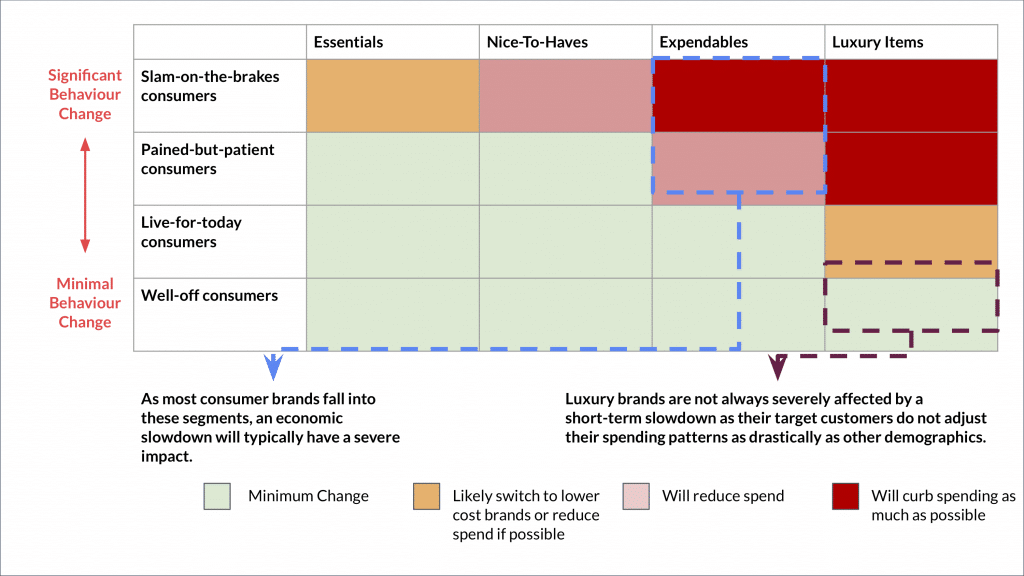Running Effective Digital Campaigns on Reduced Budgets: How Hong Kong Marketers Can Combat The Economic Slowdown (Part 2)
Economic slowdowns are typically followed by swift budget cuts. This makes it critical for marketers to demonstrate that they contribute to defending the company’s bottom line, rather than being just considered a ‘cost centre’. This article will provide some actionable recommendations towards achieving this goal by selecting campaign messages that are more likely to resonate with consumers on a tighter budget.
Understand Consumption Priorities for the Products or Services that You Sell
An important component to tackling a recession is to make a realistic evaluation of the value your brand provides from a consumption priority perspective:
- Do you sell essential products or services that consumers cannot live without? Groceries, air conditioning units and other everyday items, but also products like medicine will fall into this category.
- Do you sell items that are ‘nice-to-have’ but essentially expendable? Most consumer goods fall into this category.
- Do you sell items that are entirely expendable (or can be postponed)? Travel, organic food, or cinema tickets are good examples for this category.
- Do you sell luxury goods? Brands that enjoy high degrees of brand awareness and can charge prices significantly above their category average fall in this category (Louis Vuitton, Porsche, Rolex, etc.).
If you overlay the above listed Consumption Priorities with the Consumer Behaviour Segments introduced in the first article of this article series an interesting pattern emerges:
Whereas most brands are to some degree affected by an economic slowdown, most likely not all of their existing customers are changing their purchase behaviour. The figure below shows that. Only ‘slam-on-the-brakes’ and ‘pained-but-patient’ consumers are likely to make significant adjustments. Although most consumers fall in these two segments, it makes sense for brands understand which customers are more likely to decrease purchase frequency and/or average order value and to focus their marketing efforts more on those who are less likely to spend less.

Souce: based on https://hbr.org/2009/04/how-to-market-in-a-downturn-2
Effective Campaign Messaging during an Economic Slowdown
An important implication of the analysis carried out in the last section is that brands should shift their messaging during an economic slowdown. The more brands can highlight the long-term benefits of their products or services, the less likely consumers are to consider them ‘expendable’ (or to postpone a purchase).
Take skincare products as an example: during a slowdown beauty brands could focus their campaigns more on the long-term benefits of a rigorous skincare regime and highlight the importance of sticking to a comprehensive skincare regime to prevent long-term factors such as skin ageing effectively.
The same rationale applies to other industries: focusing on long-term benefits will help shift the perceived benefits of a product or service towards the ‘Nice-to-Have’ category, rather than the ‘Expendable’ category. This will help maintain sales levels.
Brand with severe Budget Cuts: Zeroing in on Things that Move the Needle
For brands that were affected by significant budget cuts, facing reality is very important. Focusing too much on top of the funnel campaigns when resources are scarce can be a big mistake as consumers are already less likely to spend or to try new brands. Thus the last thing a marketer with a limited budget would want to do is spend significant budget on awareness and engagement campaigns that have little impact on the bottom line.
In practice this means: Review your digital strategy by asking these basic questions?
- Are you spending a significant share of your budget on channels such as Youtube, Google Display Network or programmatic? If so it may be time to re-evaluate your media strategy.
- What are your campaign objectives? Are you focusing only on ‘awareness’, ‘website traffic’ or ‘engagement’? Same here, in times of increased scrutiny those may not be the best objectives to choose. It will be easier to defend budgets if campaigns are deployed to drive tangible business objectives such as an increase in retail store footfall, purchase frequency or cross-selling are your campaign objectives – all of these objectives can be set with digital campaigns. However, campaigns with less specific, or less tangible objectives are most likely to get axed first.
- How can you best reactivate past and/or existing customers? Email marketing, and especially in Hong Kong, SMS marketing can be very cost effective ways to drive actions and sales.
- Are you coordinating your offline and online activities? In times of a recession brands often revert to in-store discounts. While this will be effective in drawing footfall there is a risk that sales are cannibalised as consumers’ who may have also purchased at full price are now buying discounted goods (in the long-term discounts can further hurt your brand image). Instead, have you considered combining your in-store discounts with an online-to-offline campaign aimed to drive consumers to your stores who would have otherwise been unlikely to make a purchase? As First Page we have been able to achieve strong results with this approach. Get in touch if you would like us to talk you through a relevant case study.
Leverage Retargeting Effectively Across Social and Display
To further maximise campaign efficiency make sure that you break down data silos and retarget not only website visitors, but also past customers. Both Facebook and Google allow for remarketing to email and phone number lists that you have collected. The key to being successful with this is to not remarket to all past customers with the same message. Within the context of your brand apply segmentation to increase message relevancy. A jewelry brand, for instance, could use different creatives for their ads retargeting male and female customers via Facebook. Ad copy directed at men could highlight the timeliness value of the jewelry (presuming that in a recession men are concerned about spending and only want to spend on things that are “worth it”). Ad copy directed at women could emphasise the importance of not forgetting oneself in times of increased hardship.
Recap: Delivering the Right Messages to Appropriate Segments Is Key to Success
According to Google, creative quality, relevancy and personalisation are responsible for up to 70% of campaign success. That means that regardless of how sophisticated your targeting, creative does always play a vital role. In times of an economic slowdown it’s fair to assume that the importance of relevant creative messaging further increases. Hong Kong consumers are already tired of seeing celebrity driven campaigns portraying unrealistic situations that are disconnected from their own life. After all, how many of us really use our credit card to browse a stylish hat store to buy yet another stylish tifter as a means to express our uniqueness?












